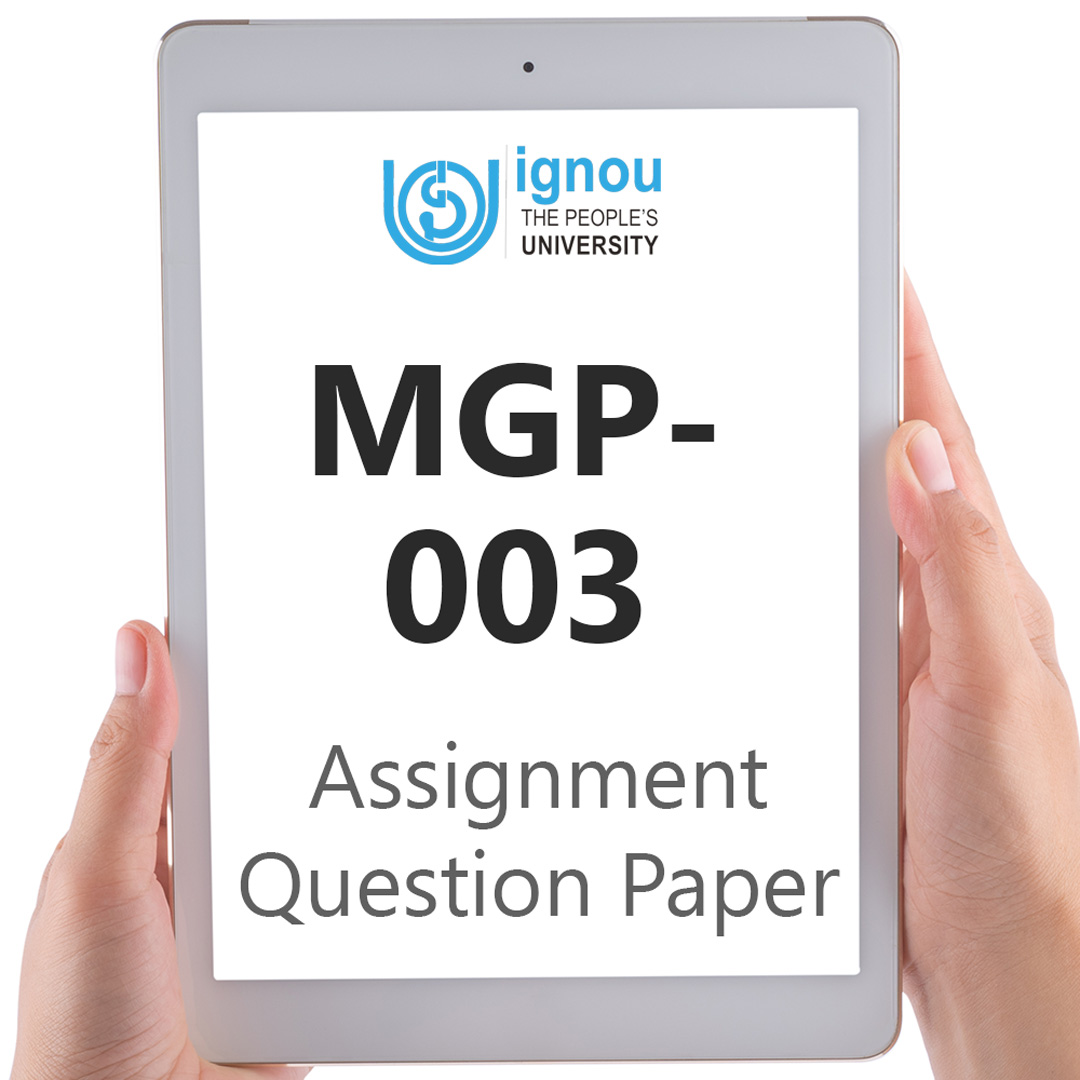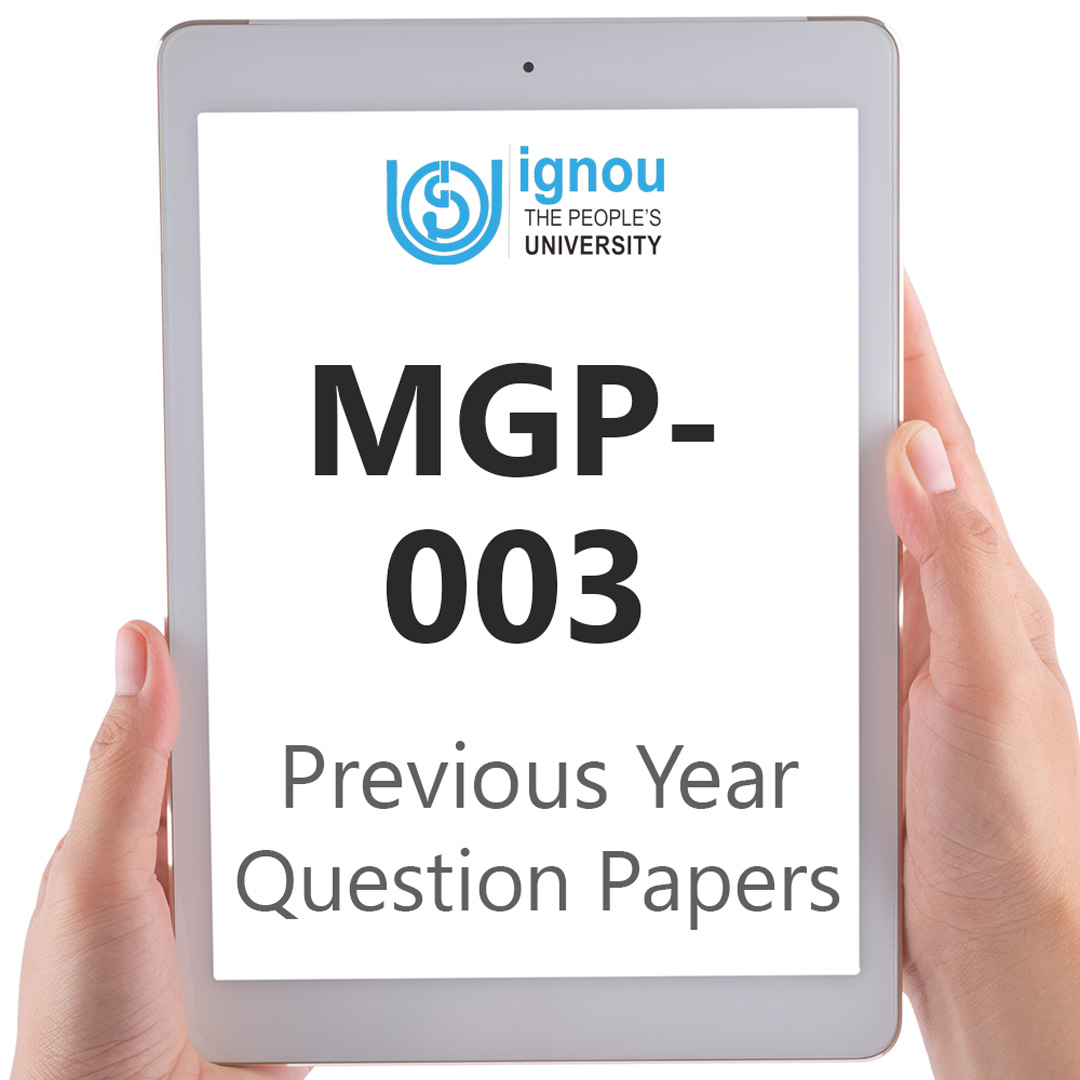If you are looking for MGP-003 IGNOU Solved Assignment solution for the subject Gandhi’s Social Thought, you have come to the right place. MGP-003 solution on this page applies to 2022-23 session students studying in MGPS, PGDGPS courses of IGNOU.
MGP-003 Solved Assignment Solution by Gyaniversity
Assignment Code: MGP-003/ASST/TMA/2022-23
Course Code: MGP-003
Assignment Name: Gandhi’s Social Thought
Year: 2022-2023
Verification Status: Verified by Professor
Answer five questions in all, selecting at least two questions from each section. Each question is to be answered in about 500 words. Each question carries 20 marks.
Section-I
Q1) Analyse the changes that have occurred in Indian society.
Ans) Over time, tradition-breaking forces have undermined the ties that united the many components of popular Indian society. Hinduism has dedicated to the idea of equality and created a sense of responsibility for society as a whole. It has undergone significant upheaval as a result of the Constitution's clauses outlining fundamental rights, changes to inheritance and marriage rules, the sacramental nature of marriage changing, and the emergence of the underdeveloped communities politically and economically.
Caste, the fundamental tenet of mainstream Hinduism, has evolved into a denial of society. A nation can never be made up of 3,000 groups of people who are strictly exclusive, socially alien to one another, and who do not mix when they eat or when they marry. Each group claims dominance over the others. The finest kinds of social endeavour are inspired by the collective consciousness of social existence, and progress is achieved through expanding the sphere of social ties and interaction. The collective awareness has a tendency to fade as it becomes entangled in the endless webs of the caste system.
Trivarnic to Chaturvarnic Society
When the curtain opens, we see the nation populated by several diverse communities working toward integration. There is the open, pastoral, trivaric Aryan civilization with its straightforward religion; earlier songs make no mention of the belief of reincarnation or concepts of purity and pollution that are analogous to those of modern Hinduism. There is the extremely advanced and distinctive urban society known as the "Dasyus."
Numerous smaller groups of people and tribes exist. The psychological and social barriers are in addition to the natural barriers. The stratification is started by the Aryans' awareness of colour and their ability to distinguish between a Dvija and an Advya. The trivarnic civilization changes to a chaturvarnic one with the addition of a new Varna, the "Shudra" or craftsman.
An abstraction, this theoretical and schematic grouping into four horizontal categories. The focus of status shifts from classes to endogamous groups. Caste becomes a fact, whereas varna remains a useful myth. By welcoming local groups into its fold and enforcing the assignment of them to lower positions in the hierarchy, caste society is able to spread. Reconciling themselves to the demeaning position of non-Dvijas and acknowledging the supremacy of the Brahmin, racial elements that are strong enough to resist assimilation and organised enough to maintain their separateness, keep their identities. Weaker groups are forced to live on the periphery of the village, outside the chaturvarnic order, and are subjected to a type of collective enslavement that is both impersonal and brutal.
Social Reformers
Mahavira and Gautama Buddha represented the uprising against ceremonial Brahminic orthodoxy by highlighting the superiority of moral behaviour over pointless ceremony. Ramanand, Kabir, Nanak, Raidas, and many others emphasised the deity of man and the guilt of depriving him of his status during the mediaeval era. Vivekananda emphasised that caste, joint families, inheritance rights, and the relationships that result from them are social and legal institutions, not religious ones, in modern times.
Rammohun Roy made an effort to rethink Hinduism by fusing the Upanishads' concepts with those of the European Enlightenment. The Vedas served as a source of inspiration for Swami Dayanand in his pursuit of a non-metaphysical view of God and society. However, the Hindu community accepted these modifications; gradually, the orthodoxy citadel was maintained. It was the Hindu society's innate vulnerability.
Q2) Examine Gandhi’s views on social change in India.
Ans) Social change is a broad concept that includes:
A shift in the social structure of a society, community of people, or other entity its character, social institutions, social behaviour, or social interactions, for example.
Once there is deviation from culturally inherited values, revolt against the established system may ensue, leading to a change in the social order. Behaviour patterns alter in huge numbers, and this change is evident and maintained.
Anything that has an impact on a group of people who share ideals or traits.
Advocacy actions for social change that are viewed as normatively desirable by the individual.
Charles Harper states that social structure is composed of "a persistent network of social interactions" in which communication between individuals or groups has become routine. The ensuing changes can have an impact on a variety of factors, including the economy and population. As it happens, other well-known agents of social change include industrialization and evolving cultural norms and values.
Measurement of some traits of a group of people is implied by the idea of social change. Although the phrase is typically used to describe improvements to society, it may also have unfavourable impacts and repercussions that threaten or end currently accepted pleasant ways of life. When Mohandas Karamchand Gandhi burst onto the Indian scene with his frugality, humility, and saintliness, this was the situation. He resembled a rishi from the past who had emerged from an epic. He had come to understand that our shortcomings, not the British weapons, were what kept us in servitude. He was aware of the caste system's stratification, regionalism, social injustice, and ignorance's flaws. He was an ardent Hindu, a man of faith, and an extremely resolute and true believer.
His Hinduism, though, was as expansive as the sky. His claim that life was indivisible and could not be divided into airtight compartments was like a breath of fresh air to the minds conditioned by the beliefs of the smritikaras, Kautilya, and Machiavelli as well as current political thought that separates the secular from the religious. There could not, in his opinion, be a break between preaching and practise. He always tried to link thought and deed, thus for him, knowing meant doing. He thought that politics and ethics were not just inextricably linked, but also interrelated. Because mass understanding is at a low level, he occasionally had to exert effort to speak at that level even if he spoke in a language that the majority of people could understand.
He noticed that although it has been argued that God is Truth, it might be more accurate to say that Truth is God. Violence is against the law of the animal, just as nonviolence is against the law of our species. Even noble goals cannot justify questionable means. Our anxieties, avarice, and egoism are our true foes. Before we can change others, we first need to change ourselves. The laws of the family, of the truth, of love, and of charity also apply to groups, nations, and states. Politicians view these as completely unrealistic ideas. However, Gandhi experienced each of them in his own life.
Q3) Critically examine Gandhi’s analysis of communal conflicts in British India.
Ans) Nearly all prominent Congress leaders, including Gopal Krishna Gokhale, Hakim Ajmal Khan, Motilal Nehru, Lala Lajpat Rai, Muhammad Ali Jinnah, and others, had fully acknowledged the multicommunal nature of the Indian polity before Gandhi rose to prominence in Indian politics, and they therefore saw Hindu-Muslim unity as a prerequisite for any advancement in that country's politics. Due to the support of all the liberal leaders in both parties, this realisation had caused the Lucknow Pact to be signed in 1916.
Gandhi, a follower of the liberal Gokhale, was also an outstanding advocate for Hindu-Muslim harmony and a supporter of an inclusive, diverse Indian society. Chapter X of his Hind Swaraj is the best example of his universal liberal nationalism. The reactionary elements were out to disseminate the rumour that the Khilafat people's real goal was not the achievement of swaraj but encouraging the Afghans to invade India and impose Muslim raj/rule here when the Khilafat and Non-cooperation Movement died out between 1923–1924.
The All-India Hindu Mahasabha started a radical agenda of Shuddhi and Sanghatan in 1923, which greatly alarmed and disturbed the Muslims. These individuals were thought to have been at the forefront of the communal riots that occurred in various parts of north India between 1924 and 1927. Political alliances were more and more based on a community basis, as Sarkar notes, and communal bodies multiplied.
The course of events and the deterioration of intercommunity ties greatly disturbed Gandhi. Gandhi replied by launching a 21-day fast as an act of penance and in order to pray for an end to the conflict between Hindus and Muslims. He attempted to identify the factors for the recent uptick in Hindu-Muslim violence in an essay that appeared in the Young India on June 5th, 1924.
According to him, these factors were:
The Malabar Mopla tenants' uprising against their caste-based Hindu landowners.
Hindu opposition was sparked by Mian Fazl-i-policy Husain's in the Punjab of allocating government posts to Muslims.
The All-India Hindu Mahasabha started the Shuddhi and Sanghatan movement.
Muslims slaughtering cows and Hindu processions playing music in front of mosques incited one another.
Hindu cowardice and Muslim bullying of Hindus during the intercommunity violence alienated Hindus from Muslims.
Muslims in developing countries have the impression that Hindus won't treat them equitably.
In keeping with this theme, he urged the satyagrahis to refrain from participating in riots, to remain impartial, or to take the side that appeared to be on the right, and to make every effort to restore intercommunal harmony as a crucial component of the Gandhian Constructive Programme. Gandhi actually reaffirmed this viewpoint by listing communal harmony as one of the objectives of the Constructive Programme. Gandhi believed that communal harmony encompassed much more than just political unity. He referred to it as the heart's indestructible union.
Section-II
Write a short note on each part of the question in about 250 words:
Q6) (a) Absolute Truth and Relative Truth
Ans) Truth could be understood through having a deeper look at the various theories that have been put forth with respect to the definition, origin, and pursuits of truth.
Absolute truth can be defined as something that is deemed to be true for all people, at all times, and in all places. Absolute truth possesses the following characteristics; it is discovered rather than being invented, it is knowable, it is not affected by the individual that profess it and it does not change and thus it can be conveyed across time. Absolute truth is also trans-cultural meaning that it can be conveyed across different cultures and it is founded under the premise that all truths are absolute.
Relative truth on the other hand is built on the understanding of truth on the basis of the naturalist world-view. It states that there is nothing like absolute truth and that truth originates in man. The beliefs that are attributed to relative truth include the fact that truth is created rather than discovered. This therefore follows that there is no universal truth since truth is mainly invented.
Different individuals and cultures are thus expected to define truth in a different way depending on their background and perspective. In relative truth, absolute truth is not knowable, truth changes and an individual’s belief can change a truth statement. Relative truth is also affected by the attitude of the person professing it. Anything can therefore be true irrespective of its origin.
Q6) (b) Gandhian approach to Hindu-Muslim unity
Ans) Gandhian approach to Hindu-Muslim unity includes the following:
Efforts for Communal Unity
Gandhi compared Hindu-Muslim unity to a marriage, where both religions should have an unwavering affection for one another. He promoted interfaith and intercultural communication to foster harmony between Hindus and Muslims. His ideas on religious pluralism and the equality of all religions, which call for tolerance of religious variety, were also a part of his efforts to promote communal harmony.
Khilafat Movement
Gandhi backed the Khilafat movement to win over Muslims to the swaraj cause. Gandhi was actually presented to the Indian Muslim masses by the Khilafat. As a result of the Khilafat problem, nonviolent cooperation movement was used for the first time in India. As a result, Hindu-Muslim collaboration entered a new era. The air was filled with the cries of "Hindu-Musalman ki jai" and "Hindu-Musalman ek Hai." This was clearly a rare attempt at togetherness, but it did not succeed for very long. Hindu-Muslim riots broke out as a result of the Khilafat's death expedited the disintegration of the tenuously balanced harmony between Muslims and Hindus. The Kohat riots and the Mopalla insurrection in the Malabar region are examples of political agitations turning into intergroup violence as a result of mixing politics and religion.
Rights of Minorities
During the struggle for liberation, Gandhi fought for the rights of minorities. He asserted that there cannot be swaraj for India unless the issue of minorities is resolved. He also made an appeal for Hindu-Muslim harmony after Partition, urging both groups to look inward rather than to the past and to accept that Hindus and Muslims would have to coexist as fellow citizens in both Pakistan and Hindustan.
Q7) (a) Gandhi’s Views on Education
Ans) Gandhi was more interested in the potential for personal growth that education offers than in the methods and content that it covers. Education, in his opinion, also awakens the soul and strengthens the inner voice. True education, in his opinion, stimulates the spiritual, intellectual, and physical capacities and results in the harmonious operation of the body, heart, mind, and soul. He believed that placing an excessive emphasis on any one of these things undermines the fundamental ideas of education and slows personal growth.
Gandhi was quite critical of the Indian educational system, calling it unnatural, wasteful, hurtful, and unethical. He claimed that the majority of the boys are lost to the parents and the profession to which they are born. They develop bad habits, adopt metropolitan lifestyles, and receive a scattering of information that may be unrelated to schooling. For these people, he advised vocational and manual training because it was the most effective way to educate a kid or an individual. They would be better able to focus on their curriculum because it required productive labour and learning methods competency.
Gandhi placed a high value on the cultural component of education, stressing that one's words and behaviour toward others should reflect one's inner culture. As a result, it is a trait of the soul rather than a cerebral endeavour. In our culture, there is no place for arrogance, prejudice, conceit, or deceit. During his time at Phoenix and Tolstoy Farms in South Africa, Gandhi tested this plan with success.
Q2) (b) Gandhi’s concept of Ahimsa (Non-Violence)
Ans) Nonviolence and satyagraha are routes to discovering the truth. In terms of empirical success, these approaches may or may not be effective, but since they follow from truth, they can never be in error. Gandhi believed that nonviolence was the only moral way to arrive to relative truth, not only a tactic to be used to achieve political gain. Nonviolence is a moral principle drawn from truth as well as a moral practise. If ahimsa is viewed solely as a strategy, it would lead us to assume that while violence may be morally acceptable, it cannot be used as a strategy.
Gandhi thought that since nonviolence is the rule of the universe and the way all species operate, it can never fail or be ineffective. Gandhi said that a strategy based on the universe's fundamental law cannot be in opposition to our concept of truth. Nonviolence is the means to the aim of truth. A person who is genuine is by definition a non-violent person, and vice versa, as aims and tactics are debatable. Truth automatically leads to nonviolence.
Nonviolence comes after truth as the guiding principle, according to this saying. He regards nonviolence as the highest moral obligation and views it broadly. The concept of nonviolence in this context refers to refraining from all forms of evil speech, including hatred, retaliation, and wishing harm on others. Nonviolence in this context refers to a decision not to violate another person's essence, as well as the refusal to cause bodily harm to others.





